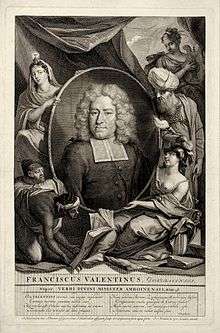François Valentijn

François Valentijn (17 April 1666 – 6 August 1727) was a Dutch minister, naturalist and author whose Oud en Nieuw Oost-Indiën ("Old and New East-India") describes the history of the Dutch East India Company and the countries of the Far East.
François Valentijn was born in 1666 in Dordrecht, Holland, where he lived most his life; however, he is known for his activities in the tropics, notably in Ambon, in the Maluku Archipelago.[1] Valentijn read theology and philosophy at the University of Leiden and the University of Utrecht before leaving for a career as a preacher in the Indies.
In total, Valentijn lived in the East Indies 16 years. Valentijn was first employed by the V.O.C. (Vereenigde Oost-Indische Compagnie) at the age of 19 as minister to the East Indies, where he became a friend of the German naturalist Georg Eberhard Rumpf (Rumphius). He returned and lived in Holland for about ten years before returning to the Indies in 1705 where he was to serve as army chaplain on an expedition in eastern Java. He finally returned to Dordrecht where he found time to write his Oud en Nieuw Oost-Indiën (1724–26) a massive work of five parts published in eight volumes and containing over one thousand engraved illustrations and some of the most accurate maps of the Indies of the time.[2] He died in The Hague, Netherlands, in 1727.
Valentijn probably had access to the V.O.C.'s archive of maps and geographic trade secrets, which they had always guarded jealously. Johannes van Keulen II (d. 1755) became Hydrographer to the V.O.C. at the time Valentijn's Oud en Nieuw Oost-Indiën was published. It was in the younger van Keulen's time that many of the VOC charts were first published, one signal of the decline of Dutch dominance in the spice trade.[2] One uncommon grace afforded Valentijn was that he lived to see his work published; the VOC (Dutch East India Company) strictly enforced a policy prohibiting former employees from publishing anything about the region or their colonial administration. And while, as Thomas Suárez notes, by the mid-18th century the Dutch no longer feared sharing geographic secrets, E. M. Beekman notes how "the execution of this policy was erratic and based on personal motives".[1]
While Valentijn's maps and diagrams were prized possessions, his scholarship, judging by 21st-century standards was unscrupulous. Valentijn's use of the products of other scientists' and writers' intellectual labour, passing it off as his own, reveals a penchant for self-aggrandisement. Beekman nevertheless cites him as an important figure and, given his writing style, diction and aptitude for narrative, one of the greatest Dutch prose writers of the time.[1]
References
Bibliography
- Valentijn, François (1724). Oud en Nieuw Oost-Indiën (in Dutch). Te Dordrecht: By Joannes van Braam, boekverkooper. OL 25412097M.
| Wikimedia Commons has media related to François Valentijn. |